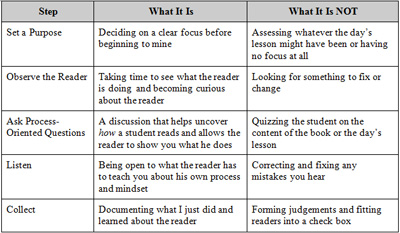 Figuring out how our students go about the process of reading can be quite challenging, which is what makes effective assessment so difficult. Much of the process remains invisible to us and often even to our students. In my new book Mindsets and Moves: Strategies That Help Readers Take Charge (Corwin, 2015), I suggest four roles we can take on so that students are supported to become truly independent of us and take charge of what, how, and why they read. In other words, students develop ownership of the process of reading so they can make choices about their reading lives. Some of those choices are what books to read, but also what to think about as you read, what to talk about with others about your reading, and what strategies to apply when needed.
Figuring out how our students go about the process of reading can be quite challenging, which is what makes effective assessment so difficult. Much of the process remains invisible to us and often even to our students. In my new book Mindsets and Moves: Strategies That Help Readers Take Charge (Corwin, 2015), I suggest four roles we can take on so that students are supported to become truly independent of us and take charge of what, how, and why they read. In other words, students develop ownership of the process of reading so they can make choices about their reading lives. Some of those choices are what books to read, but also what to think about as you read, what to talk about with others about your reading, and what strategies to apply when needed.
Too many students are simply mimicking our strategies without a clear purpose or knowledge of how those strategies actually can help them as readers. Without a purpose, a strategy actually can inhibit our comprehension, not deepen it. Think of a strategy like a tool. You don’t use any old tool to hang up a picture on the wall, you use a hammer. If you use a saw or a wrench it would not work. The same can be true for reading tools and strategies—we have to feel ownership of our process so we can choose the strategy that will help us in our books right now. So how do we as teachers figure out what strategies students might benefit from using? How do we help students reflect on whether the strategies they are using are working for them? These are worthwhile assessment questions.
The first role I suggest we take on is to be a miner. By miner, I mean uncovering what students do as readers, getting into their minds, and getting at layers of meaning that may often be hidden. There are five steps to being a miner, and each one is focused on really getting to know how a student goes about reading.
Set a purpose for what you will be mining for. What do you want to find out about this reader? You can’t look for everything, so narrowing your focus on one or two areas can help. The second step is to observe the reader closely. This means you look for students’ subtle reading behaviors such as pointing to words or moving their lips as they read as well as who seems to be reacting to their books and seems “lost in the story.” By simply observing for 20 seconds you can gain so much information and you can develop some questions you are curious to ask the reader. The third step is to ask process-oriented questions, many of which stem from the observations you just made.
 You may ask, “What are you thinking about today as you read?” or “Can you describe how you are reading this part of the book today?” These questions are meant to uncover how the student is reading, not what the student is reading. The fourth step is to listen. This sounds obvious, but with so many possible distractions and our constant rush to meet with so many students sustaining our attention on what the student explains takes effort. We listen to hear their explanation and to help students articulate their own process. The final step is to collect the information you gathered and to jot down some of what you found. This collection of information can then be used when offering feedback and when teaching. (The Reflection Chart is from Mindsets and Moves)
You may ask, “What are you thinking about today as you read?” or “Can you describe how you are reading this part of the book today?” These questions are meant to uncover how the student is reading, not what the student is reading. The fourth step is to listen. This sounds obvious, but with so many possible distractions and our constant rush to meet with so many students sustaining our attention on what the student explains takes effort. We listen to hear their explanation and to help students articulate their own process. The final step is to collect the information you gathered and to jot down some of what you found. This collection of information can then be used when offering feedback and when teaching. (The Reflection Chart is from Mindsets and Moves)
We know assessment and instruction are connected deeply, but finding the ways that make this connection work can be hard. Try being a miner and see what you uncover about the readers in your class. For now, give yourself permission to just uncover and assess.
Gravity Goldberg is a literacy consultant and author of Mindsets and Moves: Strategies That Help Readers Take Charge(Corwin, 2015) and coauthor of Conferring With Readers: Supporting Each Student’s Growth and Independence(Heinemann, 2007) in addition to managing her blog. This post is one in a series on how teachers can create more independence in the classroom by embracing new roles. She also can be reached via Twitter.